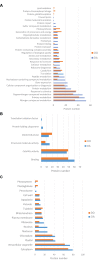Sexual and Apogamous Species of Woodferns Show Different Protein and Phytohormone Profiles
- PMID: 34868105
- PMCID: PMC8633544
- DOI: 10.3389/fpls.2021.718932
Sexual and Apogamous Species of Woodferns Show Different Protein and Phytohormone Profiles
Abstract
The gametophyte of ferns reproduces either by sexual or asexual means. In the latter, apogamy represents a peculiar case of apomixis, in which an embryo is formed from somatic cells. A proteomic and physiological approach was applied to the apogamous fern Dryopteris affinis ssp. affinis and its sexual relative D. oreades. The proteomic analysis compared apogamous vs. female gametophytes, whereas the phytohormone study included, in addition to females, three apogamous stages (filamentous, spatulate, and cordate). The proteomic profiles revealed a total of 879 proteins and, after annotation, different regulation was found in 206 proteins of D. affinis and 166 of its sexual counterpart. The proteins upregulated in D. affinis are mostly associated to protein metabolism (including folding, transport, and proteolysis), ribosome biogenesis, gene expression and translation, while in the sexual counterpart, they account largely for starch and sucrose metabolism, generation of energy and photosynthesis. Likewise, ultra-performance liquid chromatography-tandem spectrometry (UHPLC-MS/MS) was used to assess the levels of indol-3-acetic acid (IAA); the cytokinins: 6-benzylaminopurine (BA), trans-Zeatine (Z), trans-Zeatin riboside (ZR), dyhidrozeatine (DHZ), dyhidrozeatin riboside (DHZR), isopentenyl adenine (iP), isopentenyl adenosine (iPR), abscisic acid (ABA), the gibberellins GA3 and GA4, salicylic acid (SA), and the brassinosteroids: brassinolide (BL) and castasterone (CS). IAA, the cytokinins Z, ZR, iPR, the gibberellin GA4, the brassinosteoids castasterone, and ABA accumulated more in the sexual gametophyte than in the apogamous one. When comparing the three apogamous stages, BA and SA peaked in filamentous, GA3 and BL in spatulate and DHRZ in cordate gametophytes. The results point to the existence of large metabolic differences between apogamous and sexual gametophytes, and invite to consider the fern gametophyte as a good experimental system to deepen our understanding of plant reproduction.
Keywords: Dryopteris affinis ssp. affinis; Dryopteris oreades; apogamy; apomixis; fern; gametophyte; plant growth regulator; proteomic.
Copyright © 2021 Fernández, Grossmann, Gagliardini, Feito, Rivera, Rodríguez, Quintanilla, Quesada, Cañal and Grossniklaus.
Conflict of interest statement
The authors declare that the research was conducted in the absence of any commercial or financial relationships that could be construed as a potential conflict of interest.
Figures






Similar articles
-
The Shared Proteome of the Apomictic Fern Dryopteris affinis ssp. affinis and Its Sexual Relative Dryopteris oreades.Int J Mol Sci. 2022 Nov 14;23(22):14027. doi: 10.3390/ijms232214027. Int J Mol Sci. 2022. PMID: 36430514 Free PMC article.
-
Differential gene expression profiling of one- and two-dimensional apogamous gametophytes of the fern Dryopteris affinis ssp. affinis.Plant Physiol Biochem. 2020 Mar;148:302-311. doi: 10.1016/j.plaphy.2020.01.021. Epub 2020 Jan 18. Plant Physiol Biochem. 2020. PMID: 32000107
-
Proteogenomic Analysis Greatly Expands the Identification of Proteins Related to Reproduction in the Apogamous Fern Dryopteris affinis ssp. affinis.Front Plant Sci. 2017 Mar 22;8:336. doi: 10.3389/fpls.2017.00336. eCollection 2017. Front Plant Sci. 2017. PMID: 28382042 Free PMC article.
-
Insights into the evolutionary history and widespread occurrence of antheridiogen systems in ferns.New Phytol. 2021 Jan;229(1):607-619. doi: 10.1111/nph.16836. Epub 2020 Aug 25. New Phytol. 2021. PMID: 32740926 Free PMC article. Review.
-
Manipulation of Phytohormone Pathways by Effectors of Filamentous Plant Pathogens.Front Plant Sci. 2019 Jun 26;10:822. doi: 10.3389/fpls.2019.00822. eCollection 2019. Front Plant Sci. 2019. PMID: 31297126 Free PMC article. Review.
Cited by
-
Proteome and Interactome Linked to Metabolism, Genetic Information Processing, and Abiotic Stress in Gametophytes of Two Woodferns.Int J Mol Sci. 2023 Aug 4;24(15):12429. doi: 10.3390/ijms241512429. Int J Mol Sci. 2023. PMID: 37569809 Free PMC article.
-
Evolutionary Analysis and Functional Identification of Ancient Brassinosteroid Receptors in Ceratopteris richardii.Int J Mol Sci. 2022 Jun 18;23(12):6795. doi: 10.3390/ijms23126795. Int J Mol Sci. 2022. PMID: 35743240 Free PMC article.
-
Sexual reproduction in land plants: an evolutionary perspective.Plant Reprod. 2025 May 12;38(2):12. doi: 10.1007/s00497-025-00522-4. Plant Reprod. 2025. PMID: 40355640 Free PMC article. Review.
-
The Shared Proteome of the Apomictic Fern Dryopteris affinis ssp. affinis and Its Sexual Relative Dryopteris oreades.Int J Mol Sci. 2022 Nov 14;23(22):14027. doi: 10.3390/ijms232214027. Int J Mol Sci. 2022. PMID: 36430514 Free PMC article.
-
A BRASSINOSTEROID INSENSISTIVE 1 receptor kinase ortholog is required for sex determination in Ceratopteris richardii.Plant Cell. 2025 May 9;37(5):koaf058. doi: 10.1093/plcell/koaf058. Plant Cell. 2025. PMID: 40341930
References
-
- Amaki W., Higuchi H. (1992). A possible propagation system of Nephrolepis, Asplenium, Pteris, Adiantum and Rumohra (Arachniodes) through tissue culture. Acta Hortic. 300, 237–244. 10.17660/ActaHortic.1992.300.33 - DOI
-
- Asker S. E., Jerling L. (1992). Apomixis in Plants. Boca Ratón, FL: CRC Press.
LinkOut - more resources
Full Text Sources

